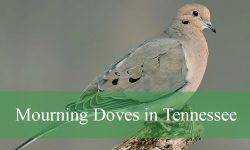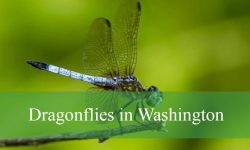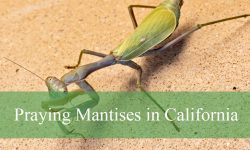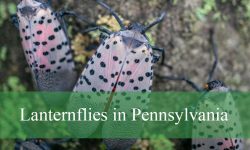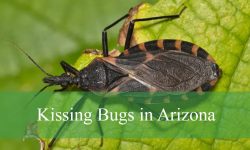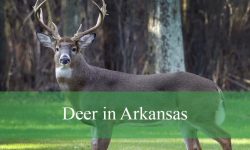Woodpeckers are among the most captivating birds in Wisconsin, known for their drumming sounds, striking colors, and unique behaviors. From small species tapping at backyard feeders to large forest dwellers echoing through the trees, these birds are a highlight for many birdwatchers.
Across the state, ten different species have been recorded, each with its own charm and habitat preferences. Some remain year-round, brightening winter days, while others migrate and return only during spring and summer. Their presence adds character to Wisconsin’s woodlands, parks, and neighborhoods.
This guide introduces all ten woodpeckers of Wisconsin with detailed identification tips, habits, and the best places to spot them. Bird enthusiasts can enjoy learning more about these fascinating species and discover where to look for both common and rare visitors.
Different Types of Woodpeckers Found in Wisconsin
Downy Woodpecker (Dryobates pubescens)
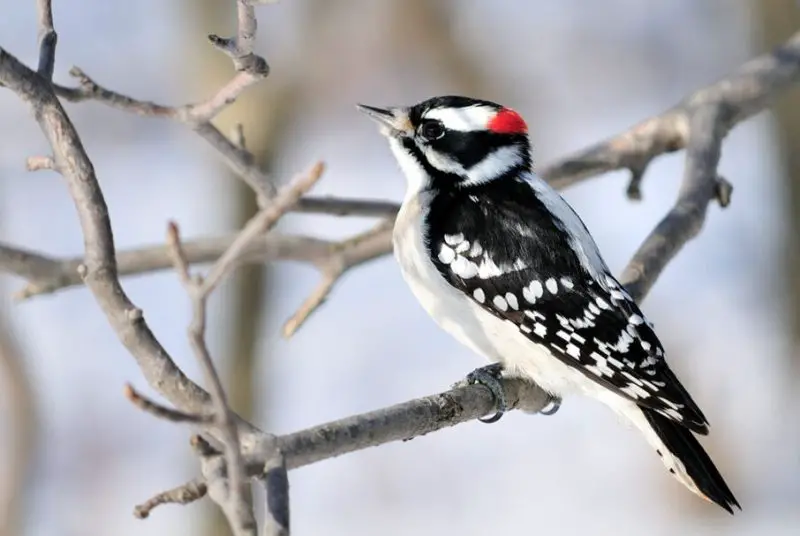
The Downy Woodpecker is the smallest and most common woodpecker in Wisconsin, making it a familiar sight in backyards, parks, and woodlands. Measuring only about 6–7 inches long, this bird has a compact body, short bill, and striking black-and-white plumage. Males have a small red patch on the back of their heads, while females lack this feature. Their crisp markings make them easy to distinguish even in winter.
Behaviorally, the Downy Woodpecker is highly adaptable. It can be seen clinging to tree trunks, hopping along branches, and even feeding on plant stems and weeds. Unlike larger woodpeckers, the Downy often forages in shrubs and small trees, which brings it closer to human habitation. They also frequently visit suet feeders, providing birdwatchers with excellent viewing opportunities.
This species feeds on insects such as beetle larvae, caterpillars, and ants, which it extracts from bark using its bill. In addition, it consumes seeds, berries, and sap. Its ability to exploit a variety of food sources contributes to its abundance throughout Wisconsin. You’ll often notice them joining mixed winter flocks of chickadees, nuthatches, and titmice.
The Downy Woodpecker remains in Wisconsin year-round and breeds across the state. It nests in dead trees or branches, where the pair excavates a small cavity for their young. Thanks to its adaptability, this species thrives in both rural and urban areas, making it a reliable companion for birdwatchers.
Hairy Woodpecker (Dryobates villosus)

The Hairy Woodpecker looks almost identical to the Downy Woodpecker but is larger, measuring about 9–10 inches long. Its bill is noticeably longer and more robust, which helps in identification. Like the Downy, it has a black-and-white plumage pattern, with males showing a small red patch on the back of the head. Side-by-side, the Hairy appears bulkier and more powerful.
In Wisconsin, the Hairy Woodpecker inhabits mature forests, wooded parks, and areas with large trees. It is less likely than the Downy to frequent small shrubs or urban feeders, though it occasionally visits suet stations. Its preference for thicker tree trunks and taller forests makes it a bit less visible, but its loud calls and drumming often give it away.
The Hairy Woodpecker primarily feeds on insects, particularly wood-boring beetle larvae and ants. Its long bill allows it to chisel deeper into bark compared to the Downy. This makes it an important species for controlling insect populations in forests. In winter, it may supplement its diet with seeds and berries.
Year-round residents of Wisconsin, Hairy Woodpeckers are cavity nesters that excavate their own nest holes. Their presence is a good indicator of healthy, older forests. Though less conspicuous than the Downy, spotting a Hairy Woodpecker can be especially rewarding for birdwatchers who pay attention to size and bill shape.
Red-bellied Woodpecker (Melanerpes carolinus)
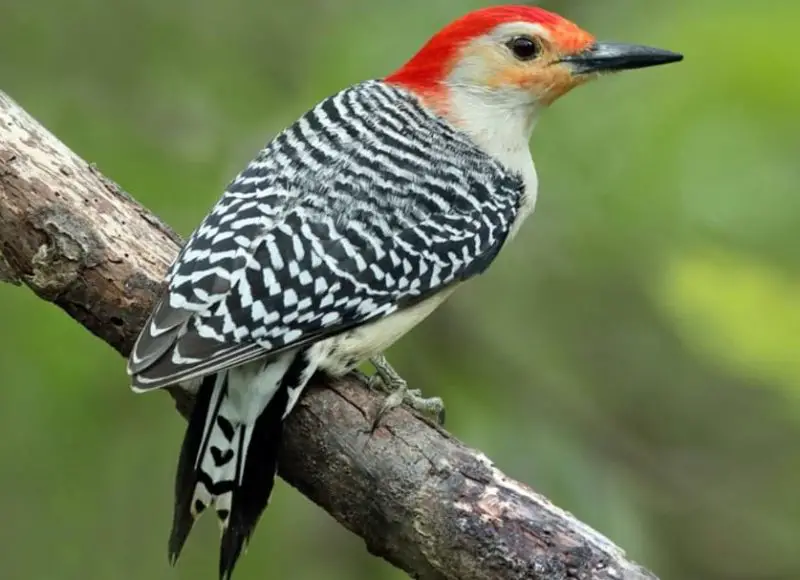
The Red-bellied Woodpecker is a medium-sized species that has become increasingly common in Wisconsin. Despite its name, its most noticeable feature is the red cap that extends from its bill over the top of its head. The “red belly” is often faint and not always visible. Its back displays striking black-and-white barring, making it easy to spot.
This woodpecker prefers wooded habitats, including deciduous forests, suburban parks, and even neighborhoods with mature shade trees. In winter, it frequently visits bird feeders, especially those offering suet, peanuts, or sunflower seeds. Its bold personality and colorful appearance make it a favorite among backyard birdwatchers.
The diet of the Red-bellied Woodpecker is varied. It feeds on insects, spiders, nuts, fruits, and seeds. Interestingly, it has been known to store food in tree crevices for later use, a behavior similar to jays and nuthatches. Its strong bill and long tongue help it probe deep into bark or snatch insects in flight.
Though historically more common in the southeastern United States, the Red-bellied Woodpecker has expanded its range northward and now thrives throughout Wisconsin. It nests in tree cavities and can raise multiple broods in a good season. Its rolling “churr” calls are often heard echoing through woodlands.
Northern Flicker (Colaptes auratus)
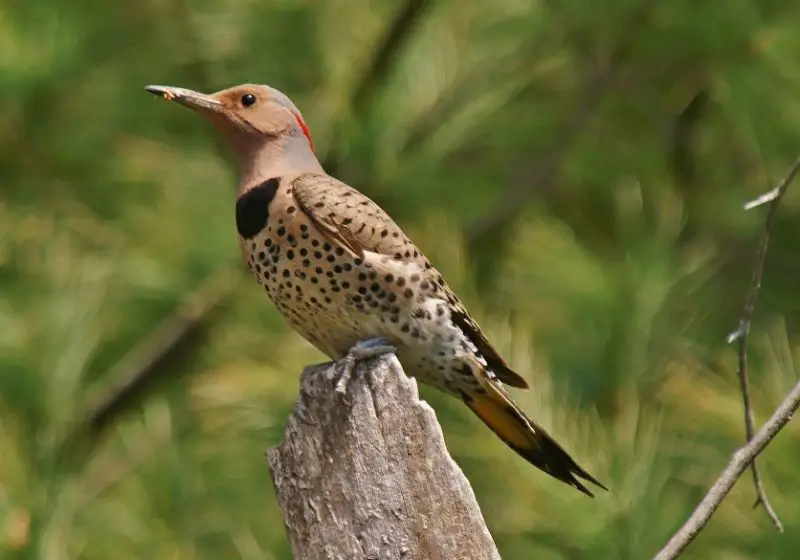
The Northern Flicker is one of the most distinctive woodpeckers in Wisconsin. Unlike most woodpeckers, it spends much of its time foraging on the ground, where it digs for ants and beetles with its slightly curved bill. This makes it an unusual but easy-to-identify species. It is about 12 inches long with a brown, barred back, spotted underparts, and a black crescent across the chest.
Two main forms exist in North America, and Wisconsin lies in the overlap zone. The “Yellow-shafted” Flicker, common in the east, shows yellow wing and tail feathers. The “Red-shafted” form, more common in the west, sometimes appears as well. Hybrids are possible, giving rise to birds with mixed features.
Northern Flickers are migratory, with many leaving Wisconsin in winter. However, some individuals remain, especially in southern parts of the state. During breeding season, they nest in tree cavities and produce loud, ringing calls and rhythmic drumming on trees, buildings, or even metal poles.
Because they forage mainly on the ground, flickers are often spotted in open areas such as lawns, fields, and forest edges. Birdwatchers should look for their characteristic white rump patch as they fly away. Their unique habits make them one of the most exciting woodpeckers to observe.
Pileated Woodpecker (Dryocopus pileatus)
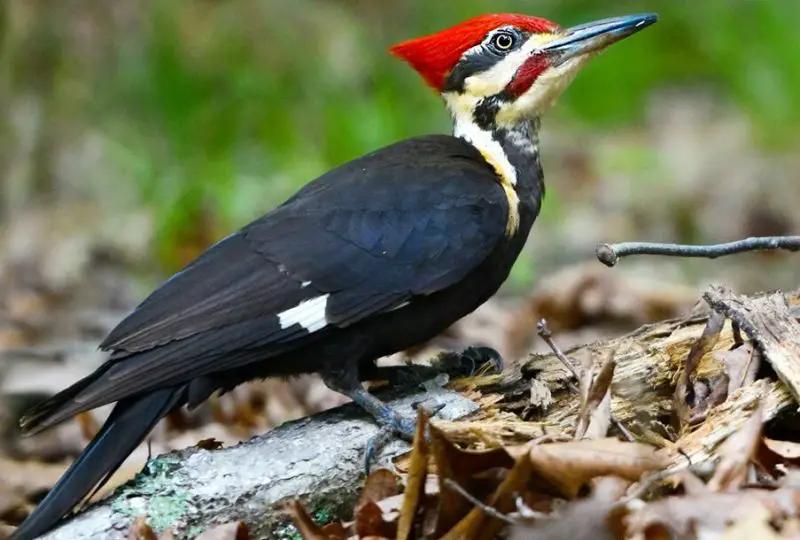
The Pileated Woodpecker is the largest woodpecker in Wisconsin and one of the most impressive birds in North America. Measuring up to 19 inches long with a wingspan of nearly 30 inches, it is about the size of a crow. Its striking red crest, black body, and bold white underwings make it unmistakable in flight.
This species prefers extensive, mature forests with large trees, where it can excavate massive rectangular holes while searching for carpenter ants. These cavities are so large that they provide nesting sites for many other bird species and mammals once abandoned. Hearing its powerful drumming echo through the forest is a thrilling experience.
Pileated Woodpeckers feed primarily on carpenter ants and wood-boring beetle larvae, but they also consume nuts, berries, and wild fruits. They can be seen tearing apart rotting logs on the forest floor or chiseling into standing dead trees. Their foraging often leaves behind rectangular scars that are easy to recognize.
Though less common than smaller woodpeckers, the Pileated population in Wisconsin has been stable and even expanding due to conservation efforts and forest regrowth. Spotting one requires patience and often a trip into mature woodland, but the reward of seeing this spectacular bird is unforgettable.
Red-headed Woodpecker (Melanerpes erythrocephalus)
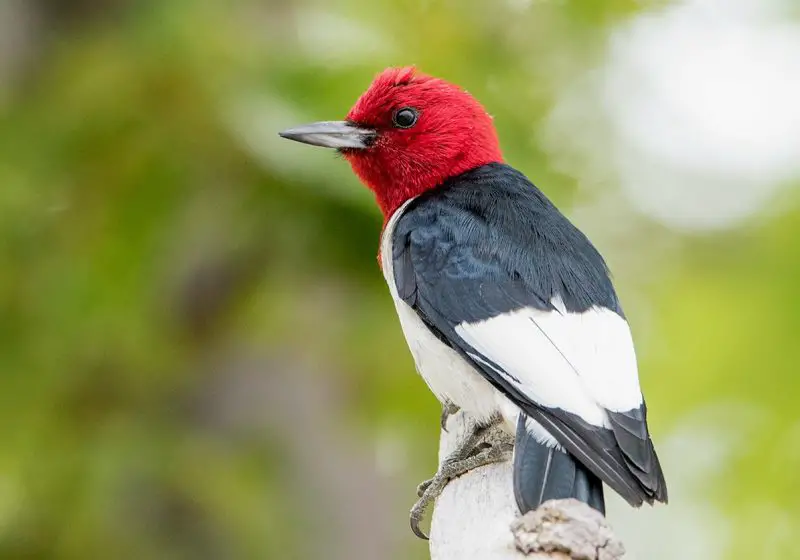
The Red-headed Woodpecker is one of the most striking woodpeckers in Wisconsin, instantly recognizable by its entirely red head, snow-white body, and glossy black wings. Unlike other species where the red patch is small, this bird’s entire head is crimson, making it a bold sight in open landscapes. Its strong contrast in plumage has earned it the nickname “the flying checkerboard.”
This species prefers open woodlands, groves of trees near water, orchards, and farmlands. It is less dependent on dense forests compared to other woodpeckers, and it often perches in conspicuous places such as fence posts or utility poles. Historically, the Red-headed Woodpecker was much more common, but its population has declined due to habitat loss and changes in land use.
Its diet is highly varied, including insects, seeds, nuts, berries, and even small vertebrates. Uniquely among woodpeckers, it actively catches insects in flight, much like a flycatcher. It also stores food in tree crevices for future use, pressing it firmly into cracks to keep it secure.
Red-headed Woodpeckers nest in tree cavities, often in dead snags or utility poles. They are still present in Wisconsin but considered less common than before. Birdwatchers are most likely to spot them in areas with scattered trees and plenty of open ground, particularly during breeding season.
Yellow-bellied Sapsucker (Sphyrapicus varius)
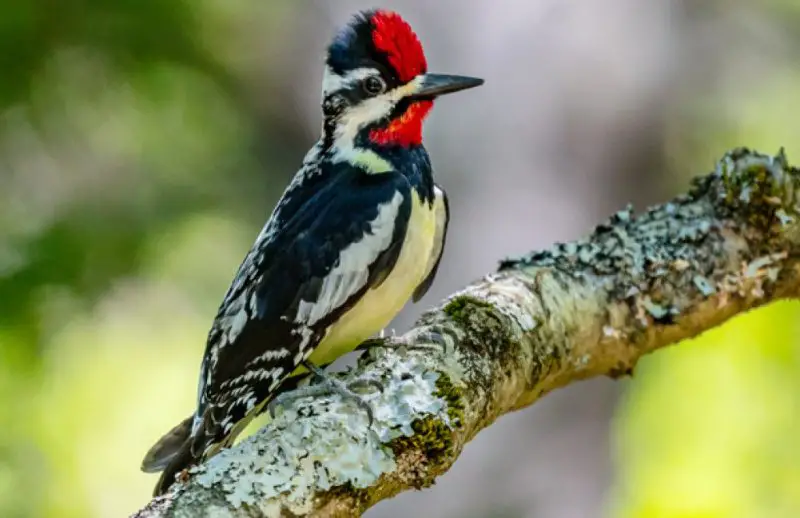
The Yellow-bellied Sapsucker is a migratory woodpecker that passes through Wisconsin during spring and fall, with some staying to breed in the northern forests. Despite its name, the yellow on its belly is usually faint and may be hard to see. It has a distinctive black-and-white pattern with bold facial stripes, and males sport a bright red throat.
As its name suggests, this species specializes in drilling neat rows of holes into tree bark to feed on sap. It laps up the sap with its brush-tipped tongue and also consumes insects attracted to the sticky fluid. Their preferred trees include birch, maple, and other hardwoods, making them important players in forest ecosystems.
In terms of behavior, the Yellow-bellied Sapsucker is less shy than some other woodpeckers and may allow close observation. Their irregular drumming patterns—often in bursts followed by pauses—make them easy to identify by sound. In migration, they can be spotted in orchards, yards, or city parks with suitable trees.
Breeding occurs mostly in northern Wisconsin, where they excavate cavities in aspen or birch trees. After summer, most migrate southward to the southeastern United States or Central America. They are not as common year-round as Downy or Hairy Woodpeckers but remain a fascinating seasonal visitor.
Black-backed Woodpecker (Picoides arcticus)
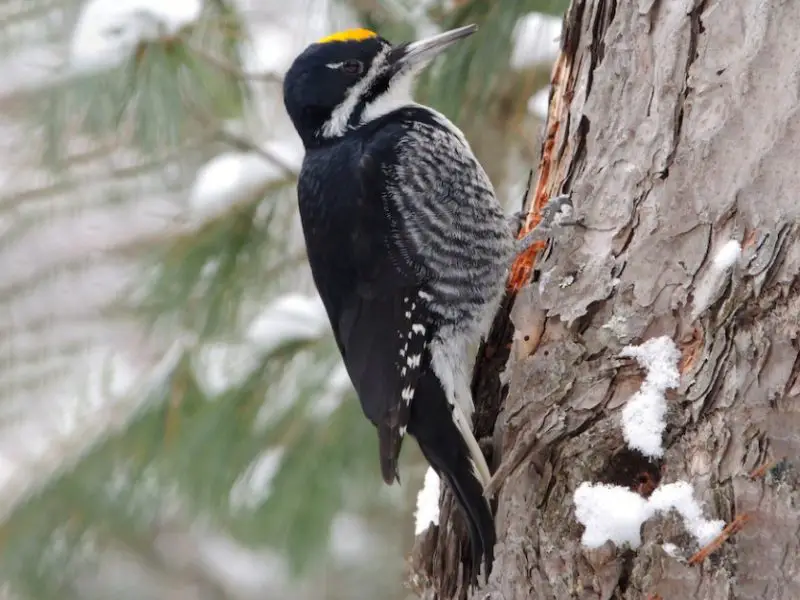
The Black-backed Woodpecker is a rare and specialized resident of northern Wisconsin’s boreal forests. Its plumage is mostly black on the back with white underparts, and males display a yellow crown patch. The dark coloring provides excellent camouflage against charred tree trunks, which is one of its preferred habitats.
This species is strongly associated with burned forests. After a wildfire, populations of Black-backed Woodpeckers often increase dramatically because they feed on wood-boring beetles that infest dead or dying trees. Over time, as the forest regenerates, their numbers decline, making them closely tied to natural disturbance cycles.
Their foraging behavior is unique: instead of constant pecking, they use their chisel-like bills to flake away bark in large strips. This allows them to expose insect larvae hidden beneath. Their role is ecologically important, as they help control pest outbreaks in fire-damaged areas.
Although present year-round, the Black-backed Woodpecker is elusive and difficult to spot. Birdwatchers hoping to find one must venture into remote northern forests, particularly areas recovering from fire. Its rarity makes any sighting a special experience for bird enthusiasts in Wisconsin.
American Three-toed Woodpecker (Picoides dorsalis)
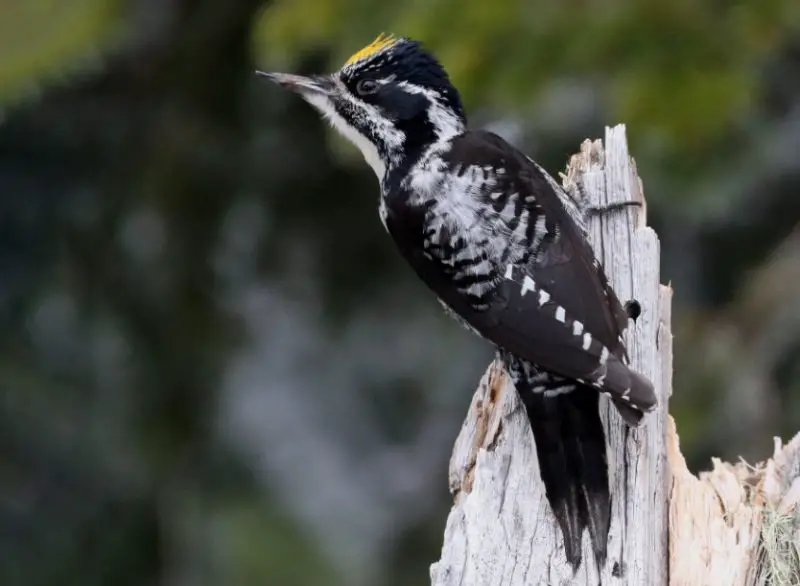
The American Three-toed Woodpecker is another scarce woodpecker in Wisconsin, restricted mainly to the northernmost parts of the state. As its name suggests, it has only three toes instead of the usual four, a unique trait among North American woodpeckers. It has a barred black-and-white back, and males display a yellow crown patch similar to the Black-backed Woodpecker.
This species favors boreal forests with spruce, fir, and tamarack, especially areas where trees are stressed or dying. Like the Black-backed Woodpecker, it often increases in numbers after forest disturbances such as fire or insect infestations. Its reliance on specific habitats makes it far less common than other Wisconsin woodpeckers.
The American Three-toed Woodpecker feeds mainly on bark beetle larvae and other insects found under the bark of conifers. It chips away bark in patches rather than creating deep excavations, leaving behind distinctive feeding signs. This foraging method helps forest managers track their presence.
Because of its rarity and secretive nature, this woodpecker is one of the least observed in Wisconsin. Birdwatchers who do encounter one usually do so in the far north, often in areas of recent forest disturbance. For many birders, spotting this elusive species is a lifetime highlight.
Lewis’s Woodpecker (Melanerpes lewis)

Lewis’s Woodpecker is an accidental and extremely rare visitor to Wisconsin, with only a handful of records in the state. Unlike most woodpeckers, it has a dark, almost crow-like appearance with a greenish-black back, gray collar, and a pinkish-red belly. Its unique plumage makes it stand out immediately if encountered.
This species is normally found in the western United States, inhabiting open pine forests, oak woodlands, and river valleys. It differs from typical woodpeckers in behavior as well. Instead of constant drumming and chiseling, Lewis’s often perches on branches like a flycatcher and swoops out to catch insects in midair.
Its diet includes flying insects, nuts, and fruits. Like the Red-headed Woodpecker, it is known for storing food, wedging acorns and other items into bark crevices for later consumption. This caching behavior helps it survive in variable environments.
Sightings of Lewis’s Woodpecker in Wisconsin are exceedingly rare, usually occurring when birds wander far from their normal range. For birdwatchers, encountering this species in the state is a remarkable and memorable event, making it one of the most special woodpecker sightings possible.
Best Time and Places to See Woodpeckers in Wisconsin
Best Time of Year
Woodpeckers can be seen in Wisconsin throughout the year, but the best time to observe them depends on the species. Common residents like the Downy, Hairy, Red-bellied, and Pileated Woodpeckers are active year-round, even during the coldest winter months when they readily visit suet feeders. Migratory species such as the Yellow-bellied Sapsucker are easiest to spot during spring migration in April and May or during their breeding season in northern forests.
Winter is an excellent season for woodpecker watching because the absence of leaves makes it easier to spot them as they move along tree trunks. Their drumming and calls are also more noticeable in the quiet winter woods. Spring brings increased activity as woodpeckers establish territories, drum loudly, and search for nesting sites, making it a lively season for birdwatchers.
Best Locations in Wisconsin
Woodpeckers inhabit a variety of habitats across the state, from backyard feeders to remote northern forests. For common species, urban parks, wooded neighborhoods, and state nature trails are reliable places to start. Downy and Red-bellied Woodpeckers are especially easy to attract to backyard feeders stocked with suet, peanuts, and sunflower seeds.
For rarer species such as the Black-backed and American Three-toed Woodpeckers, the northern regions of Wisconsin are the best bet. Areas with recent forest fires, bogs, and mature conifer stands near Lake Superior offer the greatest chance of sightings. Pileated Woodpeckers favor older forests with large trees, and they are often found in state parks such as Governor Dodge State Park, Kettle Moraine State Forest, and the Chequamegon-Nicolet National Forest.
FAQs about Woodpeckers in Wisconsin
How many species of woodpeckers are in Wisconsin?
A total of 10 woodpecker species have been recorded in Wisconsin. Some, like the Downy and Hairy Woodpeckers, are widespread and common, while others, like Lewis’s Woodpecker, are accidental and extremely rare.
Do woodpeckers stay in Wisconsin all year?
Yes, several species are permanent residents, including Downy, Hairy, Red-bellied, and Pileated Woodpeckers. Others, like the Yellow-bellied Sapsucker, migrate south in the winter and only return for the breeding season.
What is the largest woodpecker in Wisconsin?
The Pileated Woodpecker is the largest woodpecker in Wisconsin, reaching nearly 19 inches in length. Its size, loud calls, and striking red crest make it a remarkable bird to encounter in mature forests.
Which woodpeckers are rare in Wisconsin?
The Black-backed and American Three-toed Woodpeckers are considered rare residents, mostly restricted to northern boreal forests. Lewis’s Woodpecker is even rarer, with only a few accidental sightings in the state.
How can I attract woodpeckers to my backyard?
Providing suet cakes, peanuts, sunflower seeds, and fruit is the best way to attract woodpeckers. Leaving dead trees or snags standing, when safe, also provides natural nesting and feeding opportunities. A mix of food and habitat will bring multiple species to your yard year-round.

